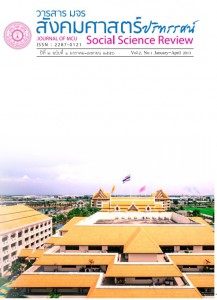กลยุทธ์การสื่อสารธรรมะ เพื่อพัฒนาเยาวชน กรณีศึกษาค่ายคุณธรรมและศูนย์การเรียนรู้พระพุทธศาสนาในพุทธมณฑล
บทคัดย่อ
การวิจัยครั้งนี้มีวัตถุประสค์เพื่อศึกษา ๑) กระบวนการสื่อสารธรรมะ ๒) กลยุทธ์การสื่อสารธรรมะ ๓) ความรู้ ทัศนคติ และความพึงพอใจของผู้เข้าอบรมธรรมะ ซึ่งใช้ระเบียบวิธีวิจัยเชิงคุณภาพ โดยศึษาจากกรสังเตการณ์แบมีส่วนร่วม การสัมภาษณ์เชิงลึก และการสนทนากลุ่มพระวิทยากร
และผู้เข้าอบมรรรมะ จำนวน ๓๖ รูป/คน และใช้วิธีวิจัยเชิงปริมาณ โดยการใช้แบบสอบถาม เพื่อ เก็บข้อมูลจากกลุ่มตัวอย่างของผู้เข้ารับการอบรม จำนวน ๓๐๙ คน
ผลการวิจัยพบว่า
๑) กระบวนการสื่อสารรรมะ เป็นการสื่อสารกลุ่มใหญ่ โดยมากจะเป็นการสื่อสารแบบกึ่งทางการ มืองค์ประกอบของการสื่อสารที่มีประสิทธิภพ ประกอบด้วย (๑) ผู้ส่งสาร เป็นผู้มีความรู้ทั้ง ทางโลกและทางธรม มีความสามารถในการสื่อสารที่ดี มีประสบการณ์มาก มีบุคลิกภาพที่น่าเชื่อถือ
สูง และมีความป็นกันเอง (๒) สาร มีทั้งภาคทฤษฎีและภาคปฏิบัติ แบ่งเป็น ๓ ภาค คือ ภาค นันทนาการ ภาควิชาการ และภาคจิตภาวนา (๓) สื่อ นั้นจะผสมผสานหลากหลายสื่อเข้าด้วยกัน ประกอบด้วย สื่อบุคคล สื่อธรรมชาติ สื่ออิเลคทรอนิกส์สื่อสิ่งพิมพ์ สื่เทคโนโลยีสมัยใหม่ สื่อวัตถุ
จำลองและสิ่งของ สื่อภาพนิและภาพคลื่อนไหว และสื่อเสียงดนตรีเสียงเพลง (๔) ผู้รับสาร มีความ แตกต่างกันไปตามอายุ เพศ การศึกษา การเป็นอยู่ เป็นตัน
๒) กลยุทธ์การสื่สารธรรมะ คือใช้เทคนิคหรือวิธีการสื่อสารที่หลากหลายผสมผสานกันไป ได้แก่ (๑) กลยุทธ์การเผยแผ่ตามหลักพุทธวิธี (๒) กลยุทธ์การสื่อสารทางวัจนภาษาประกอบด้วยการ พูดคำกลอน พูดย้อนองอิงคนสำคัญ ผูดมีสีสันด้วยการเล่นคำ พูดนำแล้วให้พูดตาม พูดหยุดความ
แล้วให้พูดต่ พูดล้อด้วยภษาถิ่ พูดเป็นศิลปัภาษาวัยรุ่น พูดหนุนด้วยภาษาต่างประเทศ พูดเปรียบเทียบอุปมา พูดจาภาษาเป็นกันเองพูดถึงเสียงกระแสสังคม พูดนิยมด้วยประสบการณ์จริง พูดอิงนิทานชดก และพูดกปัญหถมตอบ (๓) กลยุทธ์การสื่อสารทางอวัจนภาษาเพื่อเสริมวัจนภาษา
(๔) กลยุทธ์การใช้สื่แบบบูรณาการผสมผสานให้เข้ากรอบรม (๕) กลยุทธ์การสื่อสารโน้มน้าวใจและใช้จิตวิทยาการสื่อสาร
๓) ความรู้ ทัศนคติ และความพึงพอใจของกลุ่มตัวอย่างที่เข้าร่วมอบรมธรรมะในค่ายคุณธรรม จำนวน ๓๙ คน พบว่ มีความรู้ความเข้าใจในเรื่องราวทางพระพุทธศาสนาเพิ่มมากขึ้น มีทัศนคติในระดับที่ดีต่อกระบวนการสื่อสารและกลยุทธ์การสื่อสาร ตลอดทั้งมีความพึงพอใจอย่าง
มากในการเข้าร่วมอบรมธรรมะนี้
เอกสารอ้างอิง
พระมหาศักดิ์พิชิต ฐานสิทโธ. บทบาทการเผยแผ่พุทธธรรมของพระวิสุทธาธิบดี (วีระ ภกทจารี),วิทยานิพนธ์ปริญญาพุทธศสตรมหาบัณฑิต. สาขาวิชาธรรมนิเทศ. บัณฑิตวิทยาลัย :มหาวิทยามหาจุฬาลงกรณราชวิทยาสัย, ๒๕๔๙.
ภรินท ทองลิ่ม. กลยุทธ์การสื่สารในโครงการพัฒนาจิตและคุณภาพชีวิตที่มีผลต่อการตัดสินใจเลิกยาเสพติดแบบฉับพลัน. วิทยานิพนธ์ปริญญานิเทศศาสตรมหาบัณฑิต. สาขาวิชานิเทศศาสตรพัฒนาการ. บัณฑิตวิทยาลัย : จุฬาลงกรณราชวิทยาลัย, ๒๕๔๓.
วิเซียร เกตุสิห์ คู่มือการวิจัย : กรวิจัยเชิงปฏิบัติ. พิมพ์ครั้งที่ ต. กรุงเทพมหานคร : โอเดียนสโตร์,๒๕๓๗.
ดาวน์โหลด
เผยแพร่แล้ว
รูปแบบการอ้างอิง
ฉบับ
ประเภทบทความ
สัญญาอนุญาต
ลิขสิทธิ์ (c) 2018 วารสาร มจร สังคมศาสตร์ปริทรรศน์

อนุญาตภายใต้เงื่อนไข Creative Commons Attribution-NonCommercial-NoDerivatives 4.0 International License.
เพื่อให้เป็นไปตามกฎหมายลิขสิทธิ์ ผู้นิพนธ์ทุกท่านต้องลงลายมือชื่อในแบบฟอร์มใบมอบลิขสิทธิ์บทความให้แก่วารสารฯ พร้อมกับบทความต้นฉบับที่ได้แก้ไขครั้งสุดท้าย นอกจากนี้ ผู้นิพนธ์ทุกท่านต้องยืนยันว่าบทความต้นฉบับที่ส่งมาตีพิมพ์นั้น ได้ส่งมาตีพิมพ์เฉพาะในวารสาร มจร สังคมศาสตร์ปริทรรศน์ เพียงแห่งเดียวเท่านั้น หากมีการใช้ภาพหรือตารางหรือเนื้อหาอื่นๆ ของผู้นิพนธ์อื่นที่ปรากฏในสิ่งตีพิมพ์อื่นมาแล้ว ผู้นิพนธ์ต้องขออนุญาตเจ้าของลิขสิทธิ์ก่อน พร้อมทั้งแสดงหนังสือที่ได้รับการยินยอมต่อบรรณาธิการ ก่อนที่บทความจะได้รับการตีพิมพ์ หากไม่เป็นไปตามข้อกำหนดเบื้องต้น ทางวารสารจะถอดบทความของท่านออกโดยไม่มีข้อยกเว้นใดๆ ทั้งสิ้น





